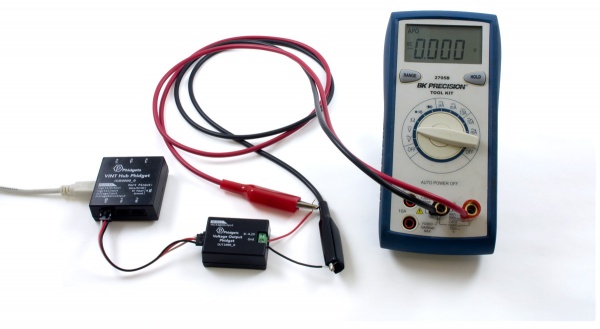OUT1000 User Guide
Part 1: Setup
Welcome to the OUT1000 user guide! In order to get started, make sure you have the following hardware on hand:
- OUT1000 - 12-bit Voltage Output Phidget
- VINT Hub
- Phidget cable
- USB cable and computer
- something to use with the OUT1000 (e.g. multimeter, oscilloscope, device with voltage input, etc.)
Next, you will need to connect the pieces:

- Connect the OUT1000 to the VINT Hub using the Phidget cable.
- Connect the VINT Hub to your computer with a USB cable.
Now that you have everything together, let's start using the OUT1000!
Phidget Control Panel
In order to demonstrate the functionality of the OUT1000, the Phidget Control Panel running on a Windows machine will be used.
The Phidget Control Panel is available for use on both macOS and Windows machines.
Windows
To open the Phidget Control Panel on Windows, find the ![]() icon in the taskbar. If it is not there, open up the start menu and search for Phidget Control Panel
icon in the taskbar. If it is not there, open up the start menu and search for Phidget Control Panel
macOS
To open the Phidget Control Panel on macOS, open Finder and navigate to the Phidget Control Panel in the Applications list. Double click on the ![]() icon to bring up the Phidget Control Panel.
icon to bring up the Phidget Control Panel.
For more information, take a look at the getting started guide for your operating system:
Linux users can follow the getting started with Linux guide and continue reading here for more information about the OUT1000.
First Look
After plugging the OUT1000 into your computer and opening the Phidget Control Panel, you will see something like this:

The Phidget Control Panel will list all connected Phidgets and associated objects, as well as the following information:
- Serial number: allows you to differentiate between similar Phidgets.
- Channel: allows you to differentiate between similar objects on a Phidget.
- Version number: corresponds to the firmware version your Phidget is running. If your Phidget is listed in red, your firmware is out of date. Update the firmware by double-clicking the entry.
The Phidget Control Panel can also be used to test your device. Double-clicking on an object will open an example.
Part 2: Using Your Phidget
About
The OUT1000 can provide a DC voltage between 0 and 4.2 volts with a resolution of 1mV. This Phidget is ideal for analog voltage-controlled devices.
Explore Your Phidget Channels Using The Control Panel
You can use your Control Panel to explore your Phidget's channels.
1. Open your Control Panel, and you will find the Voltage Output channel:

2. Double click on the channel to open an example program. This channel belongs to the Voltage Output channel class:
In your Control Panel, double click on "12-bit Voltage Output Phidget":

Part 3: Create your Program
Part 4: Advanced Topics and Troubleshooting
Before you open a Phidget channel in your program, you can set these properties to specify which channel to open. You can find this information through the Control Panel.
1. Open the Control Panel and double-click on the red map pin icon:

2. The Addressing Information window will open. Here you will find all the information you need to address your Phidget in your program.

See the Phidget22 API for your language to determine exact syntax for each property.
To ensure maximum voltage precision across the device's full range, the OUT1000 Phidget should be subjected to a minimal current draw, ideally less than 3mA. However, in the event you plan to power a small load with this device, it will either be sourcing or sinking current when in use. When it's connected to a circuit with a lower voltage potential than its own voltage setting, the current will be flowing out from the OUT1000 into the circuit, so it will be sourcing current. When it's connected to a circuit with a higher voltage potential than the voltage it's set to, the current will flow from the circuit into the OUT1000, meaning it will be sinking current.

The OUT1000 can source or sink up to 15mA of current depending on the selected output voltage. The chart below shows the maximum available voltage for a given expected current draw.

The OUT1000 may have an unpredictable output voltage for a very short time immediately after the device changes modes or is turned on. If this is a problem in your application, and you have no way to ignore it via software, we recommend using a solid-state relay to switch the output on once it has stabilized.
